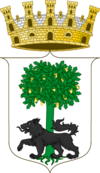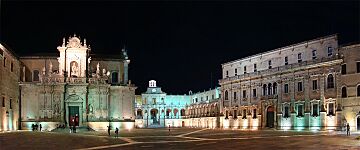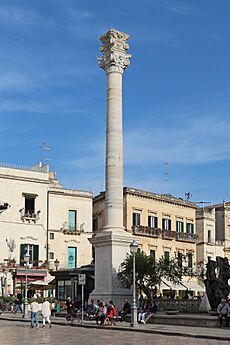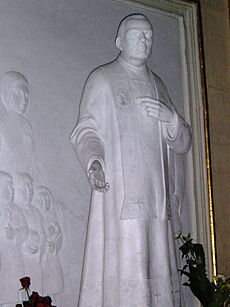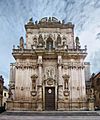Lecce facts for kids
Quick facts for kids
Lecce
Lècce (Salentino dialect)
Luppìu (Griko) |
|||
|---|---|---|---|
| Comune di Lecce | |||
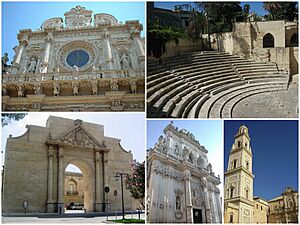
Clockwise from top left: Church of Santa Croce; Roman Theatre; the cathedral's bell tower; Lecce Cathedral ("Cattedrale di Santa Maria Assunta"); and Porta Napoli, in Viale Università
|
|||
|
|||
| Country | Italy | ||
| Region | Apulia | ||
| Province | Lecce (LE) | ||
| Founded | 200s BC | ||
| Area | |||
| • Total | 238 km2 (92 sq mi) | ||
| Elevation | 49 m (161 ft) | ||
| Population
(01-1-2023)
|
|||
| • Total | 94,783 | ||
| • Density | 398.2/km2 (1,031.5/sq mi) | ||
| Demonym(s) | Leccese | ||
| Time zone | UTC+1 (CET) | ||
| • Summer (DST) | UTC+2 (CEST) | ||
| Postal code |
73100
|
||
| Dialing code | 0832 | ||
| Patron saint | Orontius | ||
Lecce is an amazing city in southern Italy. It is the second-largest city in the Apulia region. Lecce is located on the Salentine Peninsula, which is like the "heel" of Italy's boot shape. This city is more than 2,000 years old!
Lecce is famous for its beautiful buildings. Many of them are built in a style called Baroque architecture. Because of this, Lecce is often called "The Florence of the South." A special kind of limestone found here, called "Lecce stone," is very soft. This makes it easy to carve into amazing sculptures. The stone is one of the city's main exports.
Lecce is also important for farming. It produces a lot of olive oil and wine. The city also has industries that make ceramics. You can find the University of Salento here too.
Contents
History of Lecce
Ancient Beginnings
Legend says that a city named Sybar existed here during the time of the Trojan War. It was founded by the Messapii, an ancient people. Around 300 BC, the Romans took control of the city. They renamed it Lupiae.
Later, in the 2nd century AD, the Roman emperor Hadrian moved the city about 3 kilometers (2 miles) northeast. It was then called Licea or Litium. This new city had a theater and an amphitheater. It was also connected to a port, which is now San Cataldo. Orontius of Lecce, known locally as Sant'Oronzo, was the first Christian bishop of Lecce. He is now the city's patron saint.
Medieval Times
After the Western Roman Empire fell, Lecce was attacked by the Ostrogoth king Totila. This happened during the Gothic Wars. But the city was returned to Roman rule in 549 AD. It remained part of the Eastern Roman Empire (also called the Byzantine Empire) for 500 years. During this time, it was briefly taken over by Saracens and Lombards.
In the 11th century, the Normans conquered the area. Lecce became very important again for trade and politics. Tancred of Lecce was even the last Norman King of Sicily. The city continued to grow under later rulers. The County of Lecce was a large and important area in the Kingdom of Sicily for many years.
Renaissance and Baroque Era
By the 15th century, Lecce was one of the most important cities in southern Italy. Starting in 1630, many beautiful Baroque buildings were added to the city. To protect Lecce from attacks by the Ottomans, Emperor Charles V built new walls and a castle. This happened in the early 1500s.
In 1656, a terrible plague hit the city. It sadly killed about a thousand people.
Modern History
During World War II, in 1943, fighter planes based in Lecce helped Italian soldiers. In 1944 and 1945, American B-24 long-range bombers were also based in Lecce. From here, their crews flew missions over different parts of Europe.
Exploring Lecce: Main Sights
Churches and Religious Buildings
- Church of the Holy Cross: This church is famous for its amazing decorations. Work on it started in 1353 but wasn't finished until 1695. The front of the church has detailed carvings of animals, strange figures, and plants. It also has a large rose window.
- Lecce Cathedral: The main church of Lecce was first built in 1144. It was rebuilt in 1230 and then completely restored between 1659 and 1670. Giuseppe Zimbalo did this restoration and also built the tall, 70-meter (230 ft) bell tower.
- San Niccolò and Cataldo: This church is a great example of Italo-Norman architecture. It was founded by Tancred of Sicily in 1180. The front was rebuilt in 1716, but its original Romanesque doorway was kept.
- Celestine Convent: Built between 1549 and 1695, this convent is in the Baroque style. Giuseppe Zimbalo designed it.
- Santa Irene: This church was built starting in 1591. It was dedicated to Saint Irene. The church has a large front with different styles on its upper and lower parts. Inside, it has a Latin cross shape and is quite simple.
- San Matteo: This church was built in 1667. It has a typical Baroque style from central Italy. On its front, it has two columns. Only one of them is decorated. A local story says that the jealous devil stopped the sculptor from finishing the other column!
- Santa Chiara: This church was built between 1429 and 1438, and then rebuilt in 1687.
- San Francesco della Scarpa: This church is known as the "church without a façade." This is because its front was removed during repairs in the 1800s. The oldest part of the church might be from the 1200s or 1300s.
Other Important Buildings
- Column of Saint Oronzo: This column has a statue of Saint Oronzo, Lecce's patron saint. The city of Brindisi gave it to Lecce. Saint Oronzo was believed to have cured the plague in Brindisi. This column was one of two that marked the end of the Appian Way. This was a major road between Rome and southern Italy.
- Torre del Parco ("Park Tower"): This tower is a symbol of medieval Lecce. It was built in 1419 by Giovanni Antonio Del Balzo Orsini, who was only 18 years old and the prince of Lecce. The tower is over 23 meters (75 ft) tall. It has a ditch around it where bears were once kept.
- Palazzo Sedile: Built in 1592, this building was used by the local council until 1852.
- Castle of Charles V: This castle was built between 1539 and 1549 by Gian Giacomo dell'Acaja. It has a unique trapezoid shape with strong corner towers.
- Triumphal Arch (Arco di Trionfo): This arch is often called Porta Napoli ("Neapolitan Gate"). It is one of three main gates into Lecce's old city center. It was built in 1548 to honor Charles V. The other two gates are Porta San Biagio ("St. Blaise Gate") and Porta Rudiae. Both are in the Baroque style. Porta Rudiae has a statue of Saint Oronzo on top.
- Palazzo dei Celestini: This building was designed by Giuseppe Zimbalo and built between 1659 and 1695. Today, it is the seat of the Province of Lecce.
- The city's obelisk: This tall monument was built in 1822. It honors Ferdinand I of the Two Sicilies.
Gardens and Parks
- Orto Botanico di Lecce: This is a beautiful botanical garden where you can see many different kinds of plants.
Archaeology and Ancient Sites
- The Roman 2nd century amphitheatre: This ancient theater is near Sant'Oronzo Square. It could hold more than 25,000 people! Today, it is partly buried because other buildings were built on top of it over the centuries. It is still used for various events.
- The archaeological museum Sigismondo Castromediano: Here you can learn about the history of the area.
- The archaeological museum Faggiano: Another museum with ancient artifacts.
- The archaeological park of Rudiae: This park is just outside the city. It was once an important ancient city. It has its own amphitheater, a burial ground (necropolis), and parts of old walls. The Porta Rudiae gate is named after this ancient site.
Geography and Climate
Lecce has a Mediterranean climate. This means it has hot, dry summers and mild, wet winters. It's a great place to visit almost any time of year!
Sports in Lecce
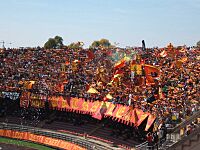
Lecce is home to the Serie A football (soccer) club U.S. Lecce. They play their games at the Stadio Via del Mare, which can hold over 33,000 fans!
Getting Around Lecce
Lecce has its own Lecce railway station, making it easy to travel by train. The city also has a trolleybus service, which started in 2012.
Famous People from Lecce
Many interesting people have come from Lecce, including:
- Carmelo Bene (1937–2002), a famous actor and film director.
- Franco Causio (born 1949), a retired football player who won the 1982 FIFA World Cup.
- Antonio Conte (born 1969), a retired football player and a well-known manager for teams like Juventus FC and the Italian national team.
- Ennio De Giorgi (1928–1996), a brilliant mathematician.
- Quintus Ennius (c. 239–169 BC), an ancient Roman writer and poet.
- Marco Materazzi (born 1973), a retired football player who won the 2006 FIFA World Cup.
- Filippo Smaldone (1848–1923), a Catholic priest who became a saint.
- Tito Schipa (1888–1965), a very famous opera singer.
Sister Cities
Lecce is twinned with several cities around the world. This means they have special friendly relationships and often share culture and ideas. These cities include:
- Murcia, Spain (since 2004)
- Skopje, North Macedonia (since 2005)
- Ostrów Wielkopolski, Poland (since 2006)
- Valladolid, Spain (since 2009)
- Amasya, Turkey
Images for kids
-
The beautiful Basilica di Santa Croce
-
The grand Triumphal Arch
See also
 In Spanish: Lecce para niños
In Spanish: Lecce para niños



